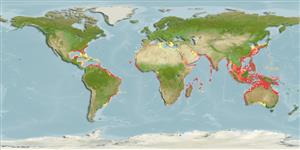Elasmobranchii (tubarões e raias) (sharks and rays) >
Carcharhiniformes (Ground sharks) >
Carcharhinidae (Requiem sharks)
Etymology: Carcharhinus: karcharos (Gr.), sharp or jagged; rhinus, an ancient name for sharks, from rhine (Gr.), rasp, both words alluding to a shark's jagged, rasp-like skin. (See ETYFish); brevipinna: brevis (L.), short; pinna (L.) fin, referring to small pectoral and first dorsal fins. (See ETYFish).
Environment: milieu / climate zone / depth range / distribution range
Ecologia
marinhas associadas(os) a recifes; oceanódromo (Ref. 51243); intervalo de profundidade 0 - 100 m (Ref. 27000), usually 0 - ? m (Ref. 55179). Subtropical; 40°N - 38°S, 100°W - 155°E (Ref. 55179)
Atlantic, Mediterranean and Indo-West Pacific, warm temperate and tropical (Ref. 58085). Often referred to as Carcharhinus limbatus in the past.
Length at first maturity / Tamanho / Peso / Idade
Maturity: Lm 205.8, range 170 - 266 cm
Max length : 300 cm TL macho/indeterminado; (Ref. 26999); common length : 250 cm TL macho/indeterminado; (Ref. 30573); peso máx. Publicado: 89.7 kg (Ref. 40637); Idade máx. registada: 16 anos (Ref. 127272)
Espinhos dorsais (total) : 0; Espinhos anais: 0. A slender shark with a long, narrow, pointed snout, long gill slits and small, narrow-cusped teeth; first dorsal fin small; no interdorsal ridge; labial furrows longer than in any other grey shark (Ref. 5578). Grey above, white below, with a conspicuous white band on sides; second dorsal, anal, undersides of pectorals and lower caudal-fin lobe black or dark grey-tipped in subadults and adults, but unmarked or nearly so in small individuals (Ref. 9997).
Found on the continental and insular shelves from close inshore to offshore (Ref. 244). Makes vertical spinning leaps out of the water as a feeding technique in which the sharks spins through a school of small fish with an open mouth and then breaks the surface (Ref. 9997). Feeds mainly on pelagic bony fishes, also small sharks, cuttlefish, squids, and octopi (Ref. 244, 5578). Viviparous (Ref. 50449). Forms schools (Ref. 244). Highly migratory off Florida and Louisiana and in the Gulf of Mexico (Ref. 244). Regularly caught in fisheries where found (Ref. 244). Utilized fresh and dried salted for human consumption (Ref. 244). Fins probably used in the oriental shark fin trade, and livers for vitamin oil production (Ref. 9997).
Viviparous, with a yolk-sac placenta; bears up to 20 young (Ref. 5578); 3-15 pups (Ref.58048). Size at birth 60 to 80 cm (Ref. 6871). Distinct pairing with embrace (Ref. 205).
Compagno, L.J.V., 1984. FAO Species Catalogue. Vol. 4. Sharks of the world. An annotated and illustrated catalogue of shark species known to date. Part 2 - Carcharhiniformes. FAO Fish. Synop. 125(4/2):251-655. Rome: FAO. (Ref. 244)
Categoria na Lista Vermelha da IUCN (Ref. 130435)
Utilização humana
Pescarias: espécies comerciais; peixe desportivo: sim
Ferramentas
Relatórios especiais
Descarregue XML
Fontes da internet
Estimates based on models
Preferred temperature (Ref.
123201): 22 - 29, mean 27.4 °C (based on 3950 cells).
Phylogenetic diversity index (Ref.
82804): PD
50 = 0.5000 [Uniqueness, from 0.5 = low to 2.0 = high].
Bayesian length-weight: a=0.00380 (0.00238 - 0.00608), b=3.07 (2.94 - 3.20), in cm total length, based on LWR estimates for this species & Genus-body shape (Ref.
93245).
Nível Trófico (Ref.
69278): 4.2 ±0.6 se; based on diet studies.
Generation time: 5.2 ( na - na) years. Estimated as median ln(3)/K based on 2
growth studies.
Resiliência (Ref.
120179): Muito baixo, tempo mínimo de duplicação da população maior que 14 anos (Fec=3).
Fishing Vulnerability (Ref.
59153): High vulnerability (62 of 100).
Nutrients (Ref.
124155): Calcium = 3.98 [0.74, 21.53] mg/100g; Iron = 0.386 [0.096, 1.168] mg/100g; Protein = 23.1 [20.3, 25.3] %; Omega3 = 0.154 [0.058, 0.388] g/100g; Selenium = 16.9 [4.9, 52.4] μg/100g; VitaminA = 21.3 [7.3, 64.7] μg/100g; Zinc = 0.319 [0.150, 0.630] mg/100g (wet weight);
